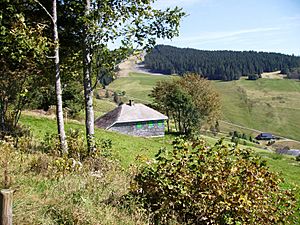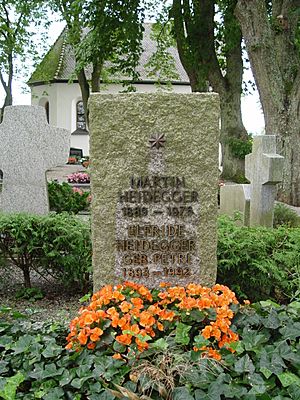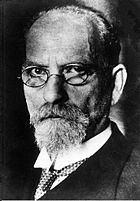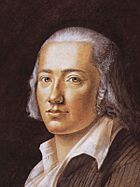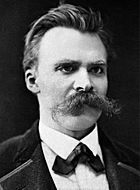Martin Heidegger facts for kids
Quick facts for kids
Martin Heidegger
|
|
|---|---|
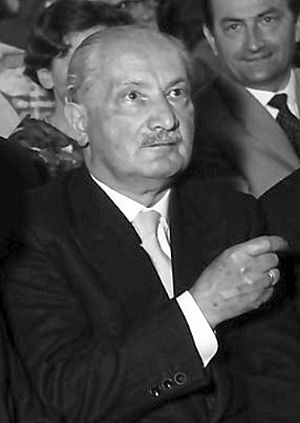
Heidegger in 1960
|
|
| Born | 26 September 1889 Meßkirch, Baden, Germany (German Empire)
|
| Died | 26 May 1976 (aged 86) |
| Education | Collegium Borromaeum (1909–1911) University of Freiburg (PhD, 1914; Dr. phil. hab. 1916) |
| Spouse(s) | Elfride Petri (m. 1917) |
| Partner(s) | Elisabeth Blochmann (1918–1969) Hannah Arendt (1924–1928) |
| Era | 20th-century philosophy |
| Region | Western philosophy |
| School | Continental philosophy Phenomenology Hermeneutics Ontological hermeneutics Hermeneutic phenomenology (early) Transcendental hermeneutic phenomenology (late) Existentialism Existential phenomenology |
| Institutions | University of Marburg University of Freiburg |
| Theses |
|
| Doctoral advisor | Arthur Schneider (PhD advisor) Heinrich Rickert (Dr. phil. hab. advisor) |
| Doctoral students | Hans Jonas |
|
Main interests
|
|
|
Notable ideas
|
|
|
Influences
|
|
|
Influenced
|
|
| Political party | Nazi Party (1933-1945) |
| Signature | |
Martin Heidegger (born September 26, 1889 – died May 26, 1976) was a German philosopher. He is known for his ideas in phenomenology, hermeneutics, and existentialism. Many people consider him one of the most important thinkers of the 20th century.
In his famous book Being and Time (1927), Heidegger introduced the term "Dasein". This word describes the special way humans exist. "Dasein" can be translated as "being there." Heidegger believed that humans already have a basic understanding of life. This understanding shapes how they live. He called this way of being "being-in-the-world." These ideas were different from older philosophies that separated the "subject" (the person) from the "object" (the world). Heidegger wanted to explore what it means for anything to "be."
About Martin Heidegger's Life
His Early Years
Martin Heidegger was born in a small town called Meßkirch, in Germany. His father was a sexton, a person who takes care of a church. His family was not wealthy enough to send him to university. So, he first joined a Jesuit seminary, a school for priests. However, he left after a few weeks due to health reasons. Heidegger was a small, strong person who loved outdoor activities like skiing.
He later studied theology at the University of Freiburg. The church supported him during this time. He then changed his studies to philosophy. In 1914, he finished his first big paper, called a doctoral thesis. In 1916, he completed another important paper, his Habilitation thesis. This paper was about a philosopher named Duns Scotus.
After his studies, he taught at the University of Freiburg from 1919 to 1923. He also served as a soldier for the last ten months of World War I.
Teaching in Marburg
In 1923, Heidegger became a professor of philosophy at the University of Marburg. Many famous thinkers were his colleagues there. His students included important people like Hans-Georg Gadamer and Hannah Arendt. At Marburg, Heidegger started to develop his main philosophical idea: the question of what it means "to be." He looked at ideas from Christian thinkers and other philosophers like Wilhelm Dilthey and Edmund Husserl.
Returning to Freiburg
In 1927, Heidegger published his most important book, Sein und Zeit (Being and Time). In 1928, he became a professor at the University of Freiburg, taking over from his former teacher, Husserl. He stayed in Freiburg for the rest of his life. Many students, including Hannah Arendt and Herbert Marcuse, studied with him there.
In 1933, Heidegger became the rector (head) of the University of Freiburg. He also joined the Nazi Party that year. There is still much debate about how his philosophy connects to his support for Nazism. He hoped to become the main philosopher for the Nazi party. However, his ideas were very complex, and other Nazi leaders did not fully support him. He resigned as rector in 1934. He remained a member of the Nazi Party until 1945.
From 1936 to 1940, Heidegger gave lectures on the philosopher Friedrich Nietzsche. He later said these lectures showed his disagreement with Nazism. However, many scholars today believe these lectures actually showed his continued support for some Nazi ideas. In 1944, during World War II, Heidegger was asked to dig anti-tank ditches.
Heidegger's private notes, called Black Notebooks, were published in 2014. These notes contain some negative ideas about Jewish people. This has led to more discussion about his connection to Nazism. Some scholars believe these ideas were central to his philosophy.
After the War
After World War II, French authorities stopped Heidegger from teaching. This was because of his connection to the Nazi Party. He went through a process called denazification. In 1949, he was classified as a "follower" of the Nazi regime. This allowed him to start teaching again at Freiburg University in 1950. He taught regularly until 1958 and gave guest lectures until 1967.
His Death
Heidegger died on May 26, 1976, in Meßkirch. He was buried in the Meßkirch cemetery.
His Personal Life
Heidegger married Elfride Petri in 1917. They had two sons, Jörg and Hermann. Heidegger knew that Hermann was not his biological son but raised him as his own. Hermann later became a historian and managed Heidegger's writings after his death.
Heidegger spent a lot of time at his vacation home in Todtnauberg, near the Black Forest. He felt that being alone in the forest helped him think deeply about philosophy.
Before he died, he met with a Catholic priest. The details of their talk are not fully known. However, the priest led Heidegger's Christian burial.
Heidegger's Main Ideas
What is Dasein?
In his 1927 book Being and Time, Heidegger disagreed with the idea that humans are just minds observing objects. Instead, he argued that people and the world are connected. He used the term Dasein (meaning "being there") to describe how humans exist. It means a "living being" through its actions of "being there" and "being-in-the-world." This "being-in-the-world" is a key part of what Dasein is.
Heidegger explored Dasein by looking at feelings like Angst (anxiety) and thinking about death. He also looked at the idea of "Care." He said Dasein is not just "man" but is the way humans can understand what it means "to be."
Understanding Being
Heidegger believed that our everyday experience of "being-in-the-world" helps us understand the "meaning of being." This understanding is how things become clear to us. He suggested that this meaning helps us understand things before we use complex logic or theories.
Heidegger said that "Being" is not like a specific thing. Instead, it is "what makes things be things." Some experts believe Heidegger's main focus was not on "Being" itself. They think he focused on how things "show up" or "are given" to us. Heidegger thought that traditional philosophy had forgotten this important question of "being."
The Role of Time
Heidegger believed that time gets its meaning from death. This means we understand time because our lives are limited. Our existence is always tied to time. We are "thrown" into a world, meaning we have a past. We also plan for the future, which involves present tasks. So, Heidegger concluded that time is a basic part of human existence.
Our human existence, or Dasein, is also connected to history. We are born into a world with a past and traditions. These traditions shape our possibilities.
Ontological Difference
In Being and Time, Heidegger made a clear difference between "beings" (things that exist) and "Being" (what it means for things to exist). He called this the "Ontological Difference." From this, he developed the idea of "Fundamental Ontology."
Traditional philosophy often asks, "Why is there anything?" Heidegger's "Fundamental Ontology" asks, "What does it mean for something to be?" It looks at what we must understand for anything to exist. This idea is central to Heidegger's philosophy. He believed that Western philosophy often focused too much on "beings" and forgot about the deeper question of "Being."
Heidegger believed that by studying human existence (Dasein), we can understand the meaning of "being." This is because humans have a basic understanding of "being" that shapes their experience.
Later Works: The Turn
Heidegger's "Kehre," or "the turn," refers to a change in his ideas that became clear by the 1940s. He started to focus more on topics like poetry and technology. Some experts describe this as a shift in his main focus. For example, his 1935 book Introduction to Metaphysics showed a shift to focusing on language, rather than just Dasein. In a 1950 lecture, he famously said, "Language speaks."
Some experts believe this "turn" was not a big change but more of a shift in how he explored his ideas. They argue that Heidegger always focused on how things "show up" or "are revealed." Important later works include "The Origin of the Work of Art" (1935) and "The Question Concerning Technology" (1954). He also wrote a lot about Friedrich Nietzsche and the poet Friedrich Hölderlin.
Heidegger and History
In his later philosophy, Heidegger tried to understand the "history of being." He wanted to show how different periods in philosophy understood "being" in different ways. His goal was to find the original understanding of "being" that he believed was present in early Greek thought. He felt this understanding had been lost by later philosophers.
Some scholars say Heidegger believed that history moves in sudden, unexpected ways. He thought that modern times had brought humanity to a new, difficult point. This point would require a new way of thinking to understand it.
Who Influenced Heidegger?
Augustine of Hippo
Heidegger was greatly influenced by Augustine of Hippo, an ancient Christian thinker. Heidegger's book Being and Time would not have been possible without Augustine's ideas. Augustine's book Confessions was especially important. Many of Heidegger's main ideas in Being and Time came from Augustine and other Christian thinkers like Martin Luther and Søren Kierkegaard.
Augustine thought that time was personal and connected to existence. Heidegger adopted similar views, believing that time exists only as long as humans do.
Aristotle and the Greeks
Heidegger was influenced early on by Aristotle, an ancient Greek philosopher. Aristotle's ideas about ethics, logic, and reality were very important to Heidegger's thinking in the 1920s. Heidegger often suggested that people should study Aristotle for many years. He challenged the traditional ways of understanding Aristotle's ideas.
The idea of asking about "being" can be traced back to ancient Greek philosophers like Parmenides. Heidegger believed that this question had been forgotten by Western philosophy after Plato and Descartes. To bring this question back, Heidegger spent a lot of time studying ancient Greek thought, including Plato, Parmenides, Heraclitus, and Anaximander.
Some scholars say Heidegger believed that the ideas of Heraclitus and Parmenides were misunderstood by Plato and Aristotle. This misunderstanding then affected all later Western philosophy. Heidegger aimed to correct this by focusing on how "beings show up" as an "unfolding event."
Wilhelm Dilthey
Heidegger's early work on understanding "actual life" was partly influenced by the writings of Wilhelm Dilthey. Dilthey's ideas helped Heidegger move away from the strict rules of some earlier philosophies.
Experts agree that Dilthey's ideas were important in shaping Heidegger's thought. Heidegger used Dilthey's concept of hermeneutics (the theory of interpretation) to develop his new ideas about "being."
Edmund Husserl
The influence of Edmund Husserl on Heidegger is a debated topic. Husserl was the founder of phenomenology, a philosophical movement. Husserl helped Heidegger become his successor at the University of Freiburg.
Some people believe Heidegger unfairly presented his work as very different from Husserl's. However, others say that Heidegger's ideas were deeply shaped by Husserl's phenomenology.
Søren Kierkegaard
Many of Heidegger's followers saw Søren Kierkegaard as a major influence on Heidegger's ideas about existence. Heidegger's ideas about anxiety (Angst) and death come from Kierkegaard. Kierkegaard emphasized the importance of our personal connection to truth, our existence in the face of death, and the temporary nature of life.
Some scholars say Heidegger's Being and Time continued Kierkegaard's goals. However, Heidegger later started to move away from some existentialist ideas.
Hölderlin and Nietzsche
The poet Friedrich Hölderlin and the philosopher Friedrich Nietzsche were very important to Heidegger. He gave many lectures about them, especially in the 1930s and 1940s. His lectures on Nietzsche focused on notes that were published after Nietzsche's death. Heidegger saw Nietzsche's ideas as a key part of Western philosophy.
Heidegger also focused on the poetry of Friedrich Hölderlin. Heidegger believed Hölderlin held a special place in history, as a thinker whose ideas were still waiting to be fully understood. Many of Heidegger's later works include thoughts on Hölderlin's poems.
Heidegger and Eastern Thought
Some experts believe Heidegger's work can connect with ideas from outside Western philosophy, especially East Asian thinking. Heidegger himself showed interest in this in his later writings. He met with Japanese thinkers, including members of the Kyoto School.
One scholar, Reinhard May, suggests that Heidegger's work was greatly influenced by Taoism and Japanese scholars. He claims that Heidegger even used ideas from German translations of Taoist and Zen Buddhist texts without giving credit.
Islam
Heidegger's ideas have also influenced studies on the link between Western philosophy and Islamic thought. Some scholars, like Nader El-Bizri, have used Heidegger's ideas to rethink concepts like "dwelling" in the modern world. This shows a connection between Western and Eastern thought.
Heidegger's ideas, along with those of Nietzsche, are also said to have influenced some Shia Islamist scholars in Iran. These thinkers helped shape the ideas behind the Iranian Revolution.
Heidegger and the Nazi Party
His Time as Rector
Adolf Hitler became the leader of Germany in January 1933. Heidegger was elected rector (head) of the University of Freiburg in April 1933. On May 1, he joined the Nazi Party.
On May 27, 1933, Heidegger gave his first speech as rector. The hall was decorated with Nazi symbols, and Nazi officials were present. His time as rector was difficult. Some Nazi officials saw him as a rival or found his ideas strange. He resigned as rector in April 1934. However, he remained a member of the Nazi Party until the end of World War II.
His Relationship with Husserl
Edmund Husserl, a German-Jewish philosopher, had supported Heidegger's work since 1917. He helped Heidegger become his successor at the University of Freiburg in 1928.
In April 1933, Nazi laws led to the firing of Jewish government employees, including professors. Husserl, who was Jewish, was forced to leave his position. Heidegger became rector shortly after this. The new national law required Jewish professors to be fired, even if they had converted to Christianity. So, Husserl's job loss was due to Nazi laws, not a specific action by Heidegger.
Heidegger stopped communicating with Husserl. In 1941, under pressure from his publisher, Heidegger agreed to remove the dedication to Husserl from his book Being and Time. This dedication was put back in later editions after the war.
In private notes from 1939, Heidegger wrote some negative comments about Jewish people. These comments seemed to suggest that Husserl's philosophy was limited because he was Jewish.
After His Rectorate
After he stopped being rector, Heidegger was less involved in politics. However, he remained a member of the Nazi Party. He also joined a committee for the Philosophy of Law in the Academy for German Law. This academy helped prepare Nazi laws, including the Nuremberg racial laws of 1935. Other important Nazi figures were also on this committee.
In a 1935 lecture, Heidegger spoke of the "inner truth and greatness" of the Nazi movement. He later added a note saying he meant "the confrontation of planetary technology and modern humanity." However, it was later found that this note was not in the original lecture. This suggests Heidegger might have tried to change his past statements after the war.
A former student, Karl Löwith, met Heidegger in 1936. Löwith recalled that Heidegger wore a Nazi pin and expressed strong support for Adolf Hitler. He also said Heidegger believed his support for Nazism fit with his philosophy.
Heidegger did not agree with the Nazis' idea of racism based on biology. Instead, he focused on a racism based on language and history.
After the War
After World War II, Heidegger was investigated for his Nazi ties. His former student Hannah Arendt spoke in his defense. He was banned from teaching between 1945 and 1951. This ban led him to become more involved with French philosophers.
In his later writings, Heidegger distanced himself from Nazism. However, some found his criticisms of Nazism troubling. He seemed to compare Nazi war crimes to other issues like industrialization.
In 1967, Heidegger met with Paul Celan, a Jewish poet who survived concentration camps. Celan later wrote a poem about the meeting. Some people believe the poem shows Celan's wish for Heidegger to apologize for his actions during the Nazi era.
Der Spiegel Interview
In 1966, Heidegger was interviewed by Der Spiegel magazine. He agreed to discuss his political past, but only if the interview was published after his death. The interview was published in 1976, five days after he died.
In the interview, Heidegger defended his involvement with Nazism. He said he had no choice and was trying to protect the university from politics. He also admitted he saw an "awakening" in the Nazi movement. He hoped it would lead to a "new national and social approach." However, he claimed he changed his mind in 1934 after the violence of the Night of the Long Knives.
Heidegger said his 1935 lecture about the "inner truth and greatness of this movement" was misunderstood. He claimed that his loyal students would know he was not praising the Nazi Party. Instead, he meant it as a comment on "the confrontation of planetary technology and modern humanity."
However, Löwith's account from 1940 contradicts Heidegger's interview. Löwith said Heidegger did not break with Nazism in 1934 and believed his philosophy supported his political involvement. The interviewers did not have all the information about Heidegger's Nazi sympathies that is known today.
Criticism of Heidegger
Early Criticisms
Husserl, Heidegger's former teacher, criticized Being and Time. He said the book claimed to be about "being" but quickly changed the topic to human existence (Dasein). Husserl felt this reduced philosophy to just studying humans.
In 1929, another philosopher, Ernst Cassirer, debated Heidegger. They discussed the meaning of Kantian ideas about freedom and reason. Cassirer defended reason, while Heidegger argued that imagination was more important.
Modern Criticisms
Some Marxist thinkers, especially from the Frankfurt School, criticized Heidegger's ideas. They connected his thinking to German irrationalism and worried about its political effects.
Initially, some members of the Frankfurt School liked Heidegger's ideas. But they became more critical in the 1930s. Heidegger's student Herbert Marcuse later rejected Heidegger's philosophy. Other thinkers from the Frankfurt School, like Jürgen Habermas, have also criticized Heidegger's influence on modern philosophy.
Heidegger in Film
- Being in the World is a film that uses Heidegger's ideas to explore what it means to be human in a world with a lot of technology. It features interviews with several Heidegger scholars.
- The Ister (2004) is a film based on Heidegger's 1942 lectures about the poet Friedrich Hölderlin.
- The film director Terrence Malick translated one of Heidegger's essays into English. It is also often said that Malick's films have ideas similar to Heidegger's.
- The 2006 short film Die Entnazifizierung des MH imagines Heidegger's denazification process.
- In the 2012 film Hannah Arendt, Heidegger is played by actor Klaus Pohl.
Images for kids
See also
 In Spanish: Martin Heidegger para niños
In Spanish: Martin Heidegger para niños



